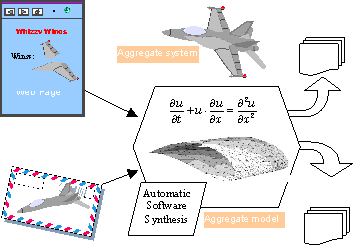
Project Overview
The key to successful collaborative design is accurate and clear communication of specifications. Whether searching for a component in a vendor’s catalog, designing a subassembly for a missile, or determining the cause of failure of an aircraft, accurate specifications of the components and their expected behaviors are essential. However, specifications are often difficult to create and are rarely computationally precise or complete. The goal of our project is to ameliorate these problems and facilitate the ubiquitous use and interchange of rich models of physical objects in everyday computing practice. We call these rich, computationally precise descriptions of physical objects active models.
In informal discussion, the behavior of a module is simply and easily communicated using algebraic and differential equations, graphs, geometric models, and logical preconditions. From a computational perspective, these mathematical expressions capture the intentional aspects of an object’s behavior without indicating how to compute the behavior. Active models consist of these mathematical descriptions of intentional behavior.
There are three components to our project. First, we are developing tools for creating, validating, exchanging, storing, and indexing active models. Second, we developing techniques for creating intentional behavioral models in response to specific questions about the behavior of an aggregate of active models. These intentional models are expressed via programs that describe the intent of the computation, but not how the computation is to be performed. Database queries, logic programming, and Web searches are other examples of intentional programming. Finally, we are developing tools that allow users to convert intentional computational specifications into executable programs. When run, these programs provide the answers to questions about the aggregate system.
An active model need not indicate how a device is to be manufactured, so a subsystem vendor can reveal forthcoming products without compromising the secrecy of the manufacturing processes. Active models are a crucial component in the creation of electronic trade shows, where products can be examined, poked, and prodded without leaving home.
If properly designed and implemented, it is possible to embed active models within a compound document. Thus, commercial off-the-shelf collaboration technologies will be able to support collaborative engineering design. In the commercial world, mail-order catalogs can contain active models instead of photographs, allowing customers to try products before purchasing them.
Technology Objective
Value
Increasing the modularity and reusability of specifications of physical objects using active model technology enhances engineering practice by improving the quality of the resulting design and improving the ability of engineers and scientists to collaborate using commercial off-the-shelf tools.
Technology Innovation
Three basic innovative technologies are used by our project:
Technology Linkages
Technology Transition
Our research leads to prototypes and proof-of-concept demonstrations. Thus, the most effective technology transfer mechanism is to familiarize Department of Defense and commercial users with our work, through demonstrations and other means, so that they will incorporate our ideas in their products. We are working with a number of companies, including Rockwell, Beam Technologies, and Xerox Research, that are investigating problems similar to ours. In addition, we are cooperating with the European based OpenMath program, which is developing related algebraic interchange tools and adopting much of our technology.

Key Milestones

Point of Contact
| DARPA Kevin W. Lyons Program Manager klyons@darpa.mil Program Homepage URL: http://radeo.nist.gov/radeo/ |
|
Cornell
University Richard Zippel Principal Investigator rz@CS.Cornell.edu Project Homepage URL: http://www2.cs.cornell.edu/SimLab/ |